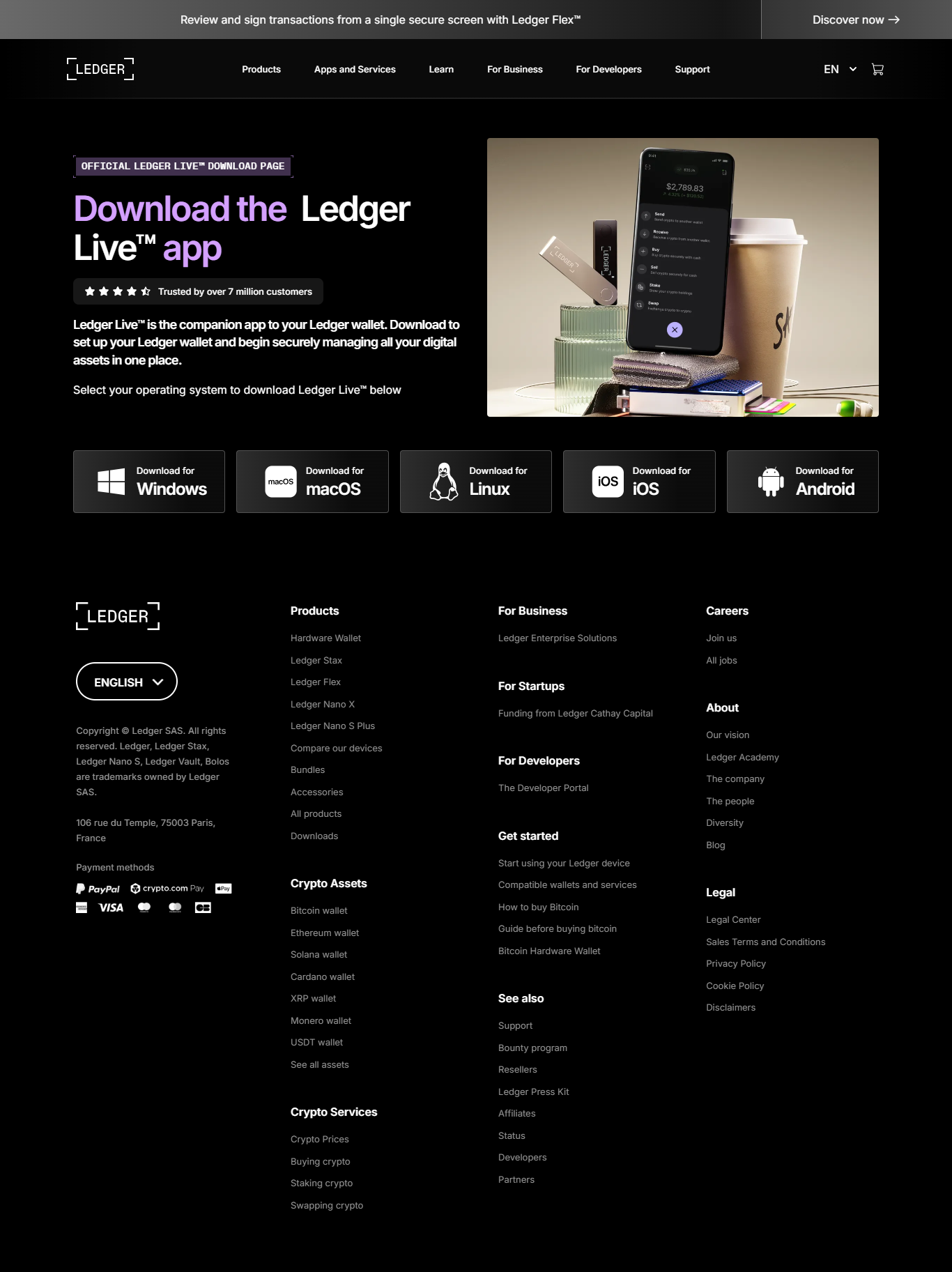Overview — what “login” means for Ledger Live
Ledger Live does not create a cloud account with a username and password like an exchange. Instead, access and transaction approval are secured by three complementary elements:
- Ledger hardware device (e.g., Ledger Nano S Plus, Nano X, Stax) — private keys remain isolated on-device.
- Device PIN — entered on the hardware wallet to unlock and sign transactions.
- Optional app-level lock — a Ledger Live password or mobile biometric lock to protect the local app interface.
In short: Ledger Live is an interface; the Ledger device is the authority. Even if your computer is compromised, attackers cannot sign transactions without physical access to your hardware device and knowledge of the device PIN.
Download and install Ledger Live
- Always start at the official page: Ledger.com/Start.
- Select the correct installer for your operating system (Windows, macOS, Linux) or download the mobile app from the App Store / Google Play.
- Run the installer and launch Ledger Live; allow updates when prompted — updates include security fixes and new device support.
Tip: Verify the app publisher in the store (developer: Ledger SAS) and bookmark the official start page to avoid phishing sites.
Desktop access flow (what “login” looks like)
On desktop, “logging in” typically means opening Ledger Live and preparing it to interact with your hardware wallet:
- Open Ledger Live. If you enabled it, enter your local app password (Settings → Security).
- Connect your Ledger device to the computer using a high-quality USB cable.
- Unlock the device by entering your PIN on the device itself.
- Open the blockchain app on the device (e.g., Bitcoin app for BTC) when prompted; Ledger Live will then display accounts and balances.
You may view portfolio information without the device if app password protection is disabled, but you cannot sign or send transactions without the physical Ledger and its PIN.
Mobile access and pairing
Ledger Live Mobile supports pairing for on-the-go management:
- Install Ledger Live from the official app store and confirm the developer is Ledger SAS.
- Unlock the app using password, Face ID, or fingerprint if you've enabled these protections.
- Pair your Ledger device:
- Nano X: pairs via Bluetooth inside Ledger Live.
- Nano S Plus: connects via USB OTG on supported Android devices.
- Enter the device PIN on the hardware wallet to approve pairing and to sign transactions.
Tip: Keep Bluetooth off when not pairing for reduced exposure on mobile devices.
App password vs. device PIN — what protects what
The app password protects Ledger Live's local data (portfolio metadata) and prevents casual viewing on the computer or phone. The device PIN secures the hardware wallet itself and is required to unlock and sign. If you forget the app password you can reset Ledger Live and reconnect your device; if you forget the device PIN you must reset the device and restore it using your 24-word recovery phrase.
Signing transactions — safe step-by-step
All transaction approvals happen on your Ledger device — never on your computer alone. Typical send flow:
- Compose the transaction in Ledger Live (recipient, amount, network fee).
- Ledger Live sends the unsigned transaction to your Ledger device for signing.
- The device displays the exact recipient address, amount, and fee — verify every field on-screen.
- Approve on the device to sign; Ledger Live then broadcasts the signed transaction to the network.
Warning: Always verify addresses and amounts on the device display. If anything differs from the app, cancel and re-check — do not approve.
Troubleshooting common login issues
Try a different USB cable or port, avoid USB hubs, restart Ledger Live and your computer, and ensure Ledger Live is up to date.
Forget the device in your phone's Bluetooth settings, then re-pair from within Ledger Live. Keep both devices close during pairing.
Clear the cache (Settings → Help → Clear cache), reinstall Ledger Live from the official site, and restart your system.
Reset Ledger Live and reconnect your Ledger device — funds remain secure because keys are on-device and recoverable with the 24-word phrase.
Lost device & recovery
If your Ledger hardware wallet is lost, damaged, or stolen, you can restore access on a new Ledger device using your 24-word recovery phrase. If the recovery phrase is lost or exposed, your funds are at risk — Ledger Support cannot recover the phrase for you. Store the recovery phrase offline, in secure locations (consider a metal backup).
Security best practices checklist
- Download Ledger Live only from Ledger.com/Start or official app stores.
- Never enter your 24-word recovery phrase into any app, website, or message — Ledger will never ask for it.
- Verify transaction details on your Ledger device screen before approving.
- Keep Ledger firmware and Ledger Live updated to receive patches and new features.
- Use strong app passwords or biometrics on shared devices for extra privacy.
- Prefer direct USB connections for firmware updates; avoid untrusted public computers.
Getting help & official support
If issues persist after basic troubleshooting, consult the official Ledger Help Center at support.ledger.com or use the in-app Help widget. Beware of unsolicited emails or social media messages claiming to be support — Ledger will never ask for your recovery phrase.
